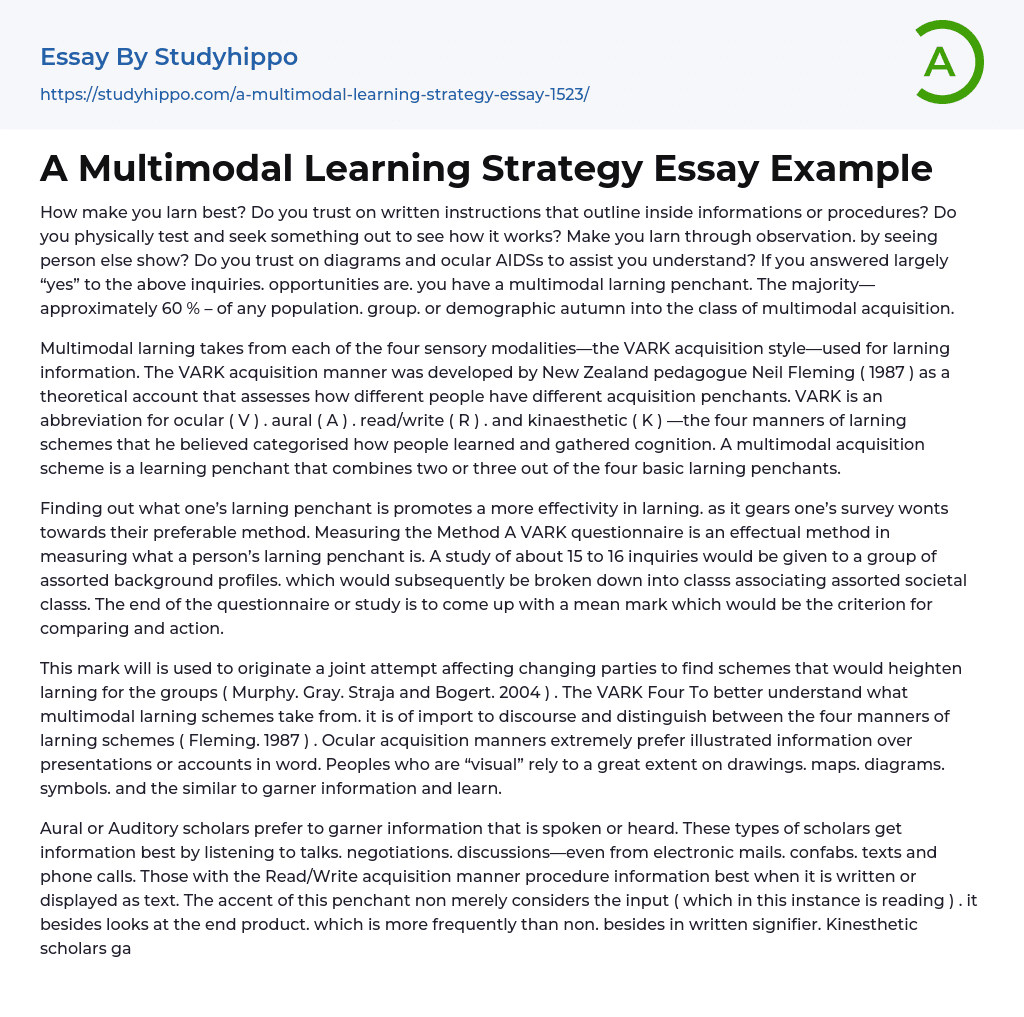How do you learn best? Do you rely on written instructions that provide details or step-by-step procedures? Do you physically experiment and try something out to see how it works? Do you learn through observation, by watching someone else demonstrate? Do you rely on diagrams and visual aids to help you understand? If you answered mostly "yes" to the above questions, chances are, you have a multimodal learning preference. Around 60% of any population, group, or demographic fall into the category of multimodal learning. Multimodal learning draws from each of the four sensory modalities - the VARK learning style - used for learning information. The VARK learning style was developed by New Zealand educator Neil Fleming (1987) as a model that assesses how different people have different learning preferences. VARK is an abbreviation for visual (V), aural (A), read/write (R), and kinae
...sthetic (K) - the four modes of learning strategies that he believed classified how people learned and gathered knowledge. A multimodal learning strategy is a preference that combines two or three out of the four basic learning preferences. Determining one's learning preference promotes more effectiveness in learning, as it aligns one's study habits with their preferred method. Evaluating the Method: A VARK questionnaire is an effective method in assessing what a person's learning preference is.A group of individuals with diverse backgrounds would receive a questionnaire or study consisting of 15 to 16 inquiries. The responses would then be categorized into different social classes. The average score obtained from the questionnaire/study would serve as a benchmark for comparison and action. This score would be used to initiate a collaborative effort between various parties in order
to determine strategies that would enhance learning for these groups (Murphy, Gray, Straja, and Bogert, 2004).
To better understand the components of multimodal learning strategies, it is important to discuss and differentiate between the four modes of learning (Fleming, 1987). Visual learners prefer visual representations such as drawings, maps, diagrams, symbols, etc., to gather information and learn. Aural or auditory learners prefer spoken or heard information. They learn best by listening to lectures, discussions, conversations, electronic communications, texts, and phone calls. Individuals with a Read/Write learning style process information most effectively when it is in written or textual form. This preference not only focuses on reading as the input but also considers the output, which is often in written form.Kinesthetic scholars acquire cognition and information through experiences, whether real or simulated. This type of "experiential learning" can be seen in simulations, presentations, and case studies. By examining the different learning preferences, we can understand how individuals with multimodal learning styles absorb and comprehend information. These preferences combine elements from the four learning styles, creating a unique approach for each person. For example, someone may have strong visual and auditory preferences, while another person may prefer reading/writing and kinesthetic learning. It is also possible for a person to have three strong preferences or no preference at all. The multimodal learning style utilizes at least two different learning strategies. Unlike individuals with single preferences who derive concepts using their preferred style, multimodal learners often feel the need to cross-reference information obtained through different learning styles. In a personal case study using the VARK questionnaire from vark-learn.com, I obtained the following scores: V=5, A=1, R=9, and K=7. These results
indicate that I have a multimodal learning preference.Countries with strengths in both Read/Write and Kinesthetic learning styles benefit from a combination of written references and hands-on experience (Vierheller, 2005). These learners gather information effectively through sources like textbooks, notes, and readings. They also enhance their learning through sensory observations, trial and error experiences, and practical approaches such as calculations, field trips, and lab work. Additionally, these individuals can produce valuable output by organizing information, creating lists, and physically demonstrating their experiences and observations. Based on personal experience, combining written information with hands-on testing has proven to be the most effective strategy. Despite scoring low in the Visual learning style, visual study methods still supplement the information gathered through the dominant learning styles. Images, diagrams, charts, symbols, and similar visual aids greatly assist in personal learning preferences. Individuals like myself, who possess a multimodal learning preference with a three-dimensional approach, have the advantage of easily adapting to various assessment methods and required techniques (Fleming, n.d.).
References:
Fleming, N. (n.d.). VARK: A Review of Those Who Are Multimodal. Retrieved from https://www.vark-learn.com/english/page_content/multimodality.
Vierheller, T. (2005). Top R & K Scores: Strategies for Success.The text below is an HTML tag with its content:
"Murphy.R. .Gray.S. .Straja.S. .and Bogert.M. (2004). Student Learning Preferences and Teaching Implication. Journal of Dental Education, 68(8), 860-861. Retrieved from World Wide Web.jdentaled.org."
- Interpretation essays
- Plagiarism essays
- Analogy essays
- Learning English essays
- Competition essays
- Effective Leadership essays
- Leadership Styles essays
- Public relations essays
- Planning essays
- Mission Statement essays
- Outsourcing essays
- Swot Analysis essays
- Business Analysis essays
- Business Plan essays
- Strategic Management essays
- Strategic Planning essays
- Reasoning essays
- Community Development essays
- Negotiation essays
- Coaching essays
- Critical Thinking essays
- homework essays
- Learning essays
- Library essays
- Listening essays
- Literacy essays
- Mentor essays
- Physical Education essays
- Project essays
- Reading essays
- Research essays
- Sex Education essays
- Social Studies essays
- Standardized Testing essays
- Study Plan essays
- Teaching essays
- Accounting essays
- Andrew Carnegie essays
- Automation essays
- Business Cycle essays
- Business Intelligence essays
- Business Model essays
- Business Operations essays
- Business Software essays
- Cooperation essays
- Cooperative essays
- Corporate Social Responsibility essays
- Corporation essays
- Customer Relationship Management essays
- Family Business essays




